定量结构-活性关系综述:数据集、分子描述符和数学模型的发展与现状
IF 3.8
2区 化学
Q2 AUTOMATION & CONTROL SYSTEMS
Chemometrics and Intelligent Laboratory Systems
Pub Date : 2024-11-21
DOI:10.1016/j.chemolab.2024.105278
引用次数: 0
摘要
开发适用于一般分子的定量结构-活性关系(QSAR)模型对许多学科的分子设计具有重要意义。本文回顾了分子 QSAR 研究的发展和现状,包括数据集、分子描述符和数学模型。一项具有代表性的文献计量分析揭示了过去十年该领域的演变趋势。在讨论现有方法的优势和不足的基础上,提出了开发广泛应用的 QSAR 模型的要求和可能的方法。这一目标对 QSAR 提出了一系列挑战,包括:(1)拥有足够数量的结构-活性关系实例作为训练数据,以应对分子结构和作用机制的复杂性和多样性;(2)开发和使用精确的分子描述符,以避免 "垃圾进,垃圾出 "的情况,同时平衡描述符维度和计算成本;以及(3)使用强大而灵活的数学模型,如深度学习模型,来学习描述符和活性之间复杂的功能关系。随着更大、更高质量的数据集、更精确的分子描述符和深度学习方法的出现,QSAR 模型的预测能力、可解释性和应用领域将不断提高,并将在分子设计的各个领域发挥更重要的作用。本文章由计算机程序翻译,如有差异,请以英文原文为准。
A review of quantitative structure-activity relationship: The development and current status of data sets, molecular descriptors and mathematical models
Developing Quantitative Structure-Activity Relationship (QSAR) models applicable to general molecules is of great significance for molecular design in many disciplines. This paper reviews the development and current status of molecular QSAR research, including datasets, molecular descriptors, and mathematical models. A representative bibliometric analysis reveals the evolutionary trends in this field in the past decade. Based on the discussion of the advantages and shortcomings of existing methods, the requirements and possible approaches for developing a widely applicable QSAR model were put forward. This goal poses a series of challenges to QSAR, including: (1) Having a sufficient number of structure-activity relationship instances as training data to cope with the complexity and diversity of molecular structures and action mechanisms; (2) Developing and using precise molecular descriptors to avoid the situation of ‘garbage in, garbage out’, while balancing descriptor dimensions and computational costs; and (3) Using powerful and flexible mathematical models, such as deep learning models, to learn complex functional relationships between descriptors and activity. With the emergence of larger and higher-quality data sets, more accurate molecular descriptors and deep learning methods, predictive ability, interpretability and application domain of QSAR models will continue to improve, and it will play a more important role in various fields of molecular design.
求助全文
通过发布文献求助,成功后即可免费获取论文全文。
去求助
来源期刊
CiteScore
7.50
自引率
7.70%
发文量
169
审稿时长
3.4 months
期刊介绍:
Chemometrics and Intelligent Laboratory Systems publishes original research papers, short communications, reviews, tutorials and Original Software Publications reporting on development of novel statistical, mathematical, or computer techniques in Chemistry and related disciplines.
Chemometrics is the chemical discipline that uses mathematical and statistical methods to design or select optimal procedures and experiments, and to provide maximum chemical information by analysing chemical data.
The journal deals with the following topics:
1) Development of new statistical, mathematical and chemometrical methods for Chemistry and related fields (Environmental Chemistry, Biochemistry, Toxicology, System Biology, -Omics, etc.)
2) Novel applications of chemometrics to all branches of Chemistry and related fields (typical domains of interest are: process data analysis, experimental design, data mining, signal processing, supervised modelling, decision making, robust statistics, mixture analysis, multivariate calibration etc.) Routine applications of established chemometrical techniques will not be considered.
3) Development of new software that provides novel tools or truly advances the use of chemometrical methods.
4) Well characterized data sets to test performance for the new methods and software.
The journal complies with International Committee of Medical Journal Editors'' Uniform requirements for manuscripts.

 求助内容:
求助内容: 应助结果提醒方式:
应助结果提醒方式:


